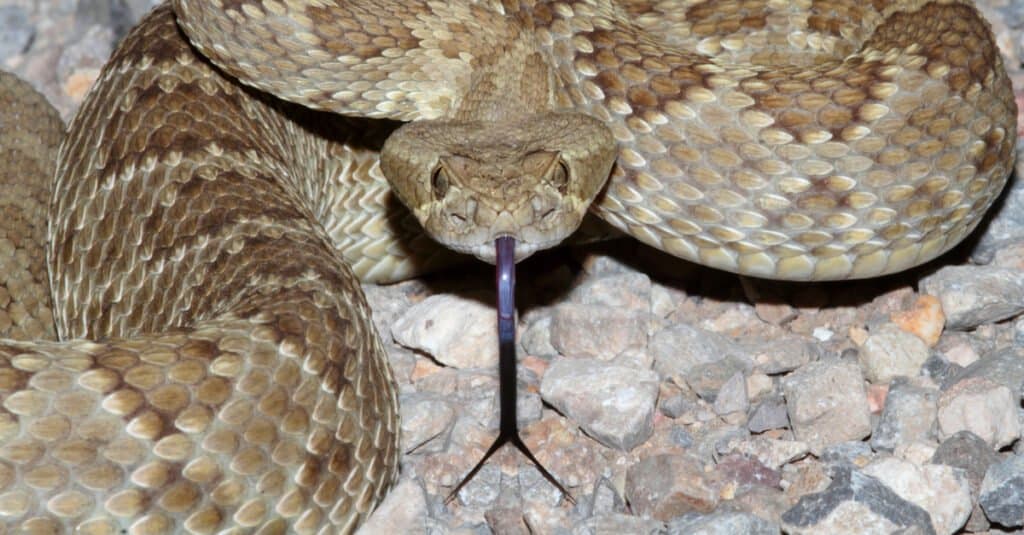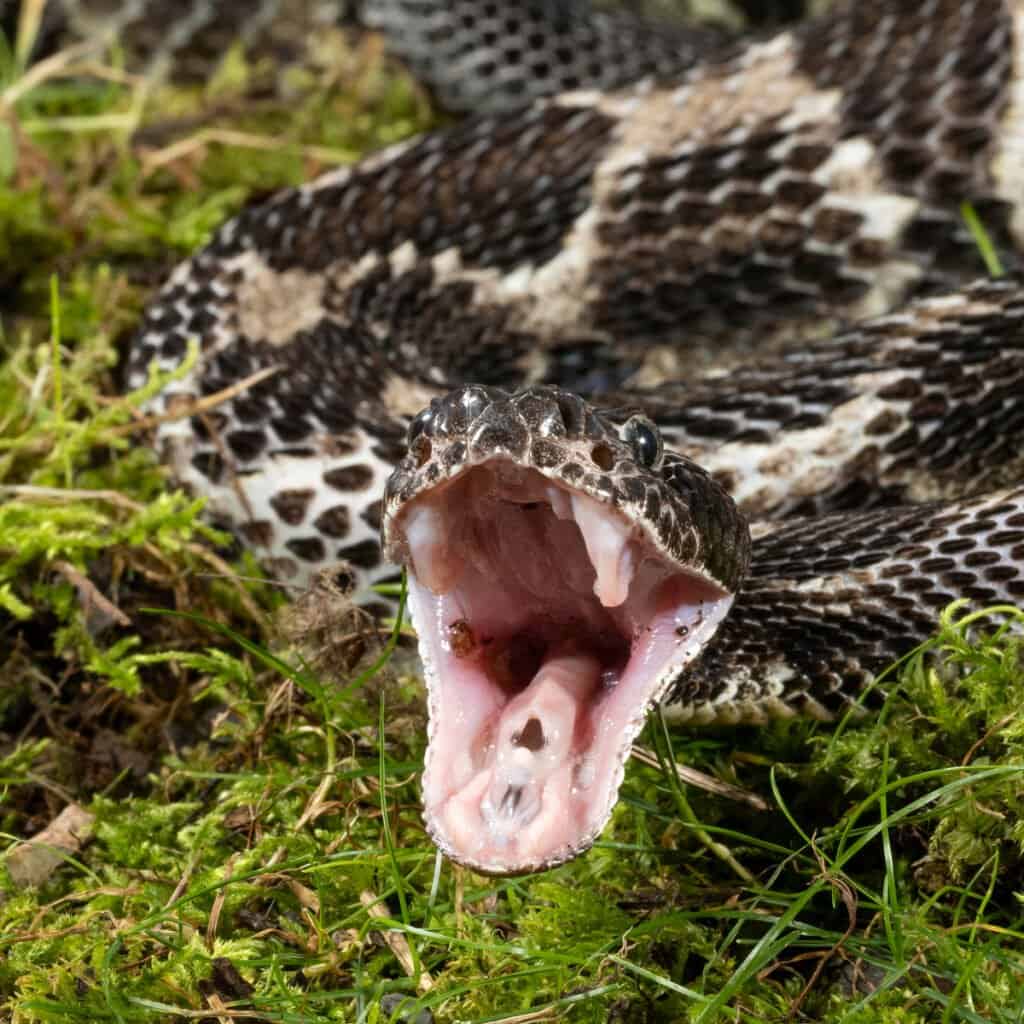Out of all the snakes in the world, rattlesnakes have one of the worst reputations. Rattlesnake heads seem almost designed to strike fear into the hearts of people and animals. It’s no wonder that so many people are afraid of rattlesnakes—their venom, if left untreated, can easily kill a person. However, fewer than 10,000 people are bitten by rattlesnakes in the United States every year. And, thanks to the availability of good quality medical care and antivenom, less than ten of those people die from their bites.
Rattlesnakes may be scary, but they’re one of the most misunderstood reptiles on the planet. Unless you wrangle snakes for a living, the odds are overwhelmingly against you ever seeing a rattlesnake, let alone sustaining a bite. But, you don’t need to see a rattlesnake in person to learn more about its unique anatomy, and what makes the rattlesnake head so interesting.
Here, we’ll learn more about recognizing rattlers. Then, we’ll take a deep dive into the exact anatomy of their heads, including their teeth, venom, and heat-sensing organs. After that, we’ll take a closer look at exactly how rattlesnakes manage to strike with such alacrity, and determine whether or not a dead snake can still bite. Finally, we’ll list a few other snakes with heads similar to the rattlesnake head.
Identifying a Rattlesnake

The rattles on the tails of rattlesnakes make it easy to identify them.
©Ali Iyoob Photography/Shutterstock.com
Rattlesnakes are easily identified by the rattles on their tails. When threatened, they use special muscles to rapidly shake the rattle back and forth, producing a characteristic, maraca-like sound. If you can’t see a rattle, or you’re not sure, then take a look at the body. Rattlesnakes are yellow to brown, with alternating diamond patterns of light and dark brown running the length of their bodies. Some of the most common species are the mojave, prairie, and timber rattlesnakes.
The Anatomy of a Rattlesnake’s Head

The rattlesnake’s head contains the eyes, venom glands, heat-sensing pits, fangs, and tongue.
©Steve Byland/Shutterstock.com
Rattlesnake heads aren’t like the heads of any other snake. Most snakes have narrow, gracile heads, some even have triangular heads. But, the rattlesnake’s head is heavy and so broad at the base that it resembles a spade or the blade of a shovel. The rattlesnake’s head is the most dangerous part of its body; it contains the eyes, venom glands, heat-sensing pits, fangs, and tongue.
Why Do Rattlesnakes Have Triangular Heads?
Rattlesnakes have such unique heads for several reasons. First, they’re venomous, and though a triangular head doesn’t always mean the snake is venomous, it certainly serves the rattlesnake well. Rattlesnakes’ triangular heads accommodate their huge fangs, as well as their large venom glands and multifarious sensory organs.
Sensory Organs
Rattlesnakes have eyes located on each side of their head, but vision isn’t their main means of locating prey. They actually use their eyes in conjunction with their tongues, nostrils, and heat-sensing pits. The heat-sensing pits are located just behind the nostrils; without them, rattlesnakes wouldn’t be able to track prey by their heat signature. But they don’t just see to hunt—they also use their tongues to transfer smells to a special organ on the roof of their mouth.
Venom
The reason rattlesnakes are so dangerous is their venom. They have what’s called hemotoxic venom—it’s designed to rapidly incapacitate and kill small animals. In humans, this venom can cause paralysis, organ failure, and even death. The venom is contained in a special venom gland located just under the eye. Each venom gland has a tube connecting it to the rattlesnake’s most fearsome weapon—its fangs.
Teeth
Rattlesnakes have teeth on both the top and bottom of their mouths. Small, needle-sharp, backward-facing teeth line their jaws. These teeth are mainly used to help swallow prey whole. The real showstoppers are the large, recurved fangs at the front corners of their mouths. Each fang can reach up to ½ inch in length; they’re hollow, like hypodermic needles. When the rattler bites, the fangs deliver venom directly into the victim’s tissues.
Rattlesnake Head: The Strike
Rattlesnakes can only bite from a coiled position. When waiting for prey, or when they’re getting ready to defend themselves, they wind their bodies up into a tight circle, with the neck held in an ‘S’ position. From here, the rattler can strike up to several feet away, and, each strike takes under half a second. That means that, no matter how fast you are, you can’t outrun a rattlesnake’s bite.
Can a Dead Rattlesnake Still Bite?

Even after death, a rattlesnake can still bite.
©Joe McDonald/Shutterstock.com
You’ve probably heard the old saying that a dead snake can still bite you, but, is it true?
When a rattlesnake dies, its nerve endings don’t stop working immediately. In many ways, a dead rattlesnake is still a functional rattlesnake. The brain might be dead, but the muscles, nerves, and head can still move. Because of this, a rattlesnake can still bite, and deliver venom, even after death. So, even if you find a dead rattlesnake, you should avoid touching it, or getting too close.
Can a Severed Rattlesnake Head Still Bite?
Because rattlesnake bodies can still bite even after death, many people recommend cutting off the head. But, can a severed rattlesnake’s head still bite? The answer is yes, a severed rattlesnake head can still be dangerous. This is because the head contains both the fangs and the venom glands. So, under the right circumstances, a freshly killed rattlesnake head can bite, and even envenomate.
What Other Snakes Have Triangular Heads?
Rattlesnakes aren’t the only type of snake with a triangular head. Many types of watersnake, ratsnake, and garter snakes also have triangular-shaped heads. Further, you can’t tell if a snake is venomous just by looking at its head shape; many non-venomous snakes have triangular heads, just like the highly venomous rattlesnake. And, some venomous species of snake have narrow, non-triangular heads.
The photo featured at the top of this post is © Max Allen/Shutterstock.com
Discover the "Monster" Snake 5X Bigger than an Anaconda
Every day A-Z Animals sends out some of the most incredible facts in the world from our free newsletter. Want to discover the 10 most beautiful snakes in the world, a "snake island" where you're never more than 3 feet from danger, or a "monster" snake 5X larger than an anaconda? Then sign up right now and you'll start receiving our daily newsletter absolutely free.
Thank you for reading! Have some feedback for us? Contact the AZ Animals editorial team.






